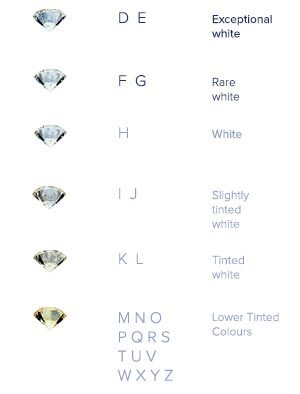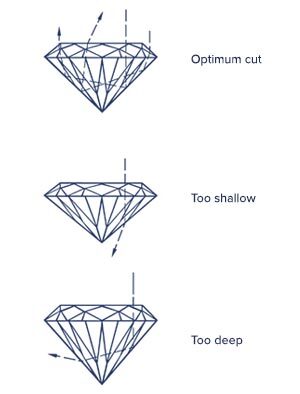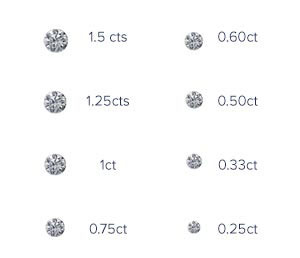Local Storage seems to be disabled in your browser.
For the best experience on our site, be sure to turn on Local Storage in your browser.
Diamond grading
Almost everyone has heard of the 4 C's Colour, Clarity, Cut, and the Carat weight, that together form the basis for the quality and the price of a diamond.
Diamonds are unique in that they have a worldwide standardised grading system which will accurately identify the quality of the diamond. This was devised by the GIA (the Gemological Institute of America) introduced in 1953, and replaced former less accurate grading systems which had broader subdivisions.
The colour is graded alphabetically from D to Z with the whitest at the top of the scale, becoming more tinted as it descends. Cellini only uses diamonds in the D-G colour range.
The clarity, which is measured by the absence, or the position, and size of naturally occuring marks (called inclusions) in the stone, is assessed over five clarity grades. Clarity is important because it has a direct effect on the brilliance of the diamond. The smaller and fewer the inclusions the higher the clarity, and the higher the diamond quality. Cellini selects and uses only IF, VVs, and Vs quality diamonds.
The quality of the cut is often ignored by many diamond sellers but is vitally important at it has such a direct effect on the brilliance of the diamond. Cutting principles based on mathematics were devised in the early 20th century, and if followed absolutely, will maximise the brilliance of the diamond. However for commercial reasons few diamonds are cut to perfect proportions. At Cellini all loose diamonds are sorted by our in-house diamond graders to ensure the highest level of brilliance.
COLOUR
 Cellini designs and makes jewellery to the highest standard and therefore uses diamonds in the highest quality.
Cellini designs and makes jewellery to the highest standard and therefore uses diamonds in the highest quality.
The whiter the diamond the higher the quality, the colour ranges from "D" (the whitest) and runs down to "Z" (the darkest). The world's whitest, rarest, and most sought after colour grade, is "D".
Colours "D&E" are extremely white, and are classified as "Exceptional White". Colours "F&G" which are very white are classified as "Rare White".
Technically, although "H" is classified as White, Cellini only selects and uses diamonds in the "D-G" colour range.
From colour "I" downwards, the diamonds are increasingly visably tinted and appear darker the further down the scale you go.
The diamond grades selected by Cellini are marked in white on the adjacent colour scale.
CLARITY
 Although the quality of a diamond is dependant on Colour, Clarity, and Cut. The Clarity of a diamond is probably of greater importance because it has a direct bearing on the brilliance of the stone.
Although the quality of a diamond is dependant on Colour, Clarity, and Cut. The Clarity of a diamond is probably of greater importance because it has a direct bearing on the brilliance of the stone.
Most diamonds are formed with natural marks (inclusions) within the diamond crystal. The fewer and smaller the inclusions, the higher the quality of the diamond.
Cellini grades and selects diamonds that are "IF" (Internally flawless, therefore no inclusions), "VVS" and "VS", (Very, Very, Small, and Very Small inclusions) that have such tiny inclusions, that they have minimal effect on the brilliance of the diamond.
"SI" Slightly Included" and "I" "Included" grades are not used by Cellini as the inclusions are of a size that will absorb a considerable amount of light and markedly reduce the brilliance of the diamond.
There are five clarity grades, which are then subdivided.
CUT
 Whilst diamond sellers frequently tend to concentrate on the "Colour" and "Clarity", the quality of the cut of a diamond is of paramount importance.
Whilst diamond sellers frequently tend to concentrate on the "Colour" and "Clarity", the quality of the cut of a diamond is of paramount importance.
Diamond is the hardest substance in the world, and therefore throughout history has presented diamond cutters with huge technical difficulties. For 800 years each generation of cutters learnt skills from their forebears, but in 1918 Marcel Tolkowski, a mathematician and member of a prominent diamond cutting family, created a radically different cut based on strictly mathematical principles. In doing so he laid down a scientific basis for future cutting which unlocked the brilliance of the diamond.
The aim of perfect cutting is to refract and reflect all the incoming light through the diamond and straight back to the viewer. There is a very precise mathematical cutting formula that will give the diamond the maximum brilliance. Surprisingly however, very few diamonds are cut with this precision; those that differ only slightly away from the perfect proportions will disperse incoming light and not appear as bright.
Every diamond at Cellini is sorted and selected by our in-house Diamond Graders who ensure that every diamond used in the designs is cut to the precise angles that achieve maximum brilliance.
CARATS
 The weight of a diamond has no bearing on its quality, as it is a unit of weight. A diamond's weight is measured in "carats" and subdivided into"points". There are 100 points to a carat, so a three quarter carat weight diamond can be referred to as .75cts or 75 points.
The weight of a diamond has no bearing on its quality, as it is a unit of weight. A diamond's weight is measured in "carats" and subdivided into"points". There are 100 points to a carat, so a three quarter carat weight diamond can be referred to as .75cts or 75 points.
One carat represents 1/5th of a gram. The name carat comes from the Ancient Greek "Keraton" and is derived from the use of the seeds of the carob tree as weights in ancient times to weigh precious stones. Because the seeds were largely a uniform weight, and as they were readily available, they effectively represented a standardised weight system in the Ancient World.
However there were very small variations in weight between indivdual seeds, and in 1914 it was decided to regularlise the weight to be 1/5th of a gram, creating the metric carat.
